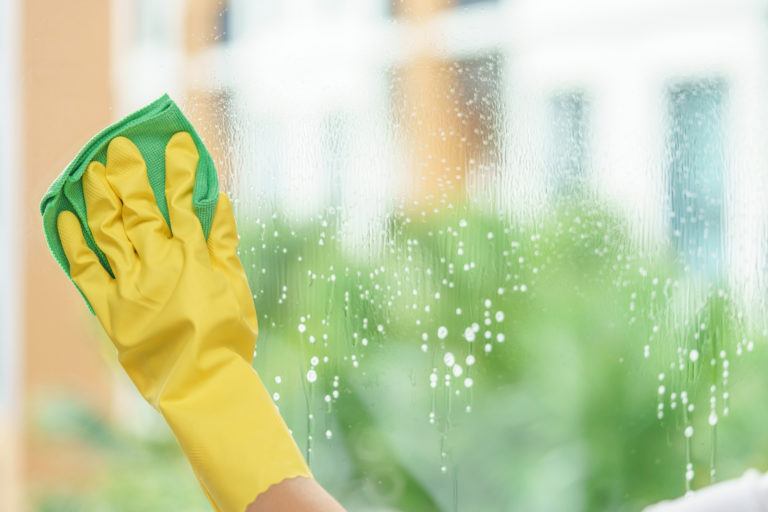
Quick Tips
- Before you learn how to clean windows, you'll want to gather the necessary tools for the operation.
- Next, quickly dust or wipe down the area around the window.
- The greatest thing about learning how to clean windows from a pro like myself, is acquiring this remarkable recipe for window cleaner.
- To clean larger windows, use the sponge.
- To dry the larger windows, you'll need the squeegee and the microfiber cloth.
- Your windows should now be almost imperceptible.
I strive to avoid tasks like cleaning windows. Even with years of scum, dirt, and watermarks built up – they’re still functional, aren’t they? You can still discern between night and day…most of the time. Even so, a few weeks ago I decided that cleaning them might be rewarding. Perhaps being able to see his breath fog up the window would make the guy outside our bedroom more exotic and exciting to guests. I also had been feeling guilty about my commitment to the neighborhood watch.
Because it had been about a decade since I’d last practiced the art, I had to relearn how to clean windows. I did recall some things – for example, that it is best to clean windows on a cloudy day. Window cleaner will dry too quickly in direct sunlight, which will lead to streaking (not for you…the windows). I also knew that there are many safe, environmentally friendly home recipes for window cleaner. Read on and learn how to clean your windows in a green, safe way that will leave them spotless.
How to Clean Windows like a Professional
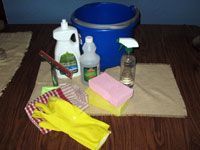 Before you learn how to clean windows, you’ll want to gather the necessary tools for the operation. Find a bucket, sponge, a kitchen towel or old (but clean) cotton shirt, a microfiber cloth, a spray bottle (optional), some cleaning gloves and a squeegee. This may seem like a long list, but keep in mind that I have a variety of different window sizes. As you read, you might find that not every last item is needed for the job you are doing. For window cleaning solution, I use warm water, white vinegar, and a splash of dish soap.
Before you learn how to clean windows, you’ll want to gather the necessary tools for the operation. Find a bucket, sponge, a kitchen towel or old (but clean) cotton shirt, a microfiber cloth, a spray bottle (optional), some cleaning gloves and a squeegee. This may seem like a long list, but keep in mind that I have a variety of different window sizes. As you read, you might find that not every last item is needed for the job you are doing. For window cleaning solution, I use warm water, white vinegar, and a splash of dish soap.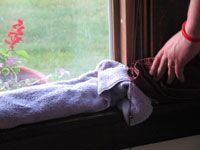 Next, quickly dust or wipe down the area around the window. This will save you time once you have cleaner on the windows, as you’ll avoid adding grime to the solution. Next, put down some towels along the window sills and the floor. Any major spills or drips should be wiped up immediately. If you can, it is best to rinse the outdoor side of the windows with a hose to remove mineral buildups.
Next, quickly dust or wipe down the area around the window. This will save you time once you have cleaner on the windows, as you’ll avoid adding grime to the solution. Next, put down some towels along the window sills and the floor. Any major spills or drips should be wiped up immediately. If you can, it is best to rinse the outdoor side of the windows with a hose to remove mineral buildups.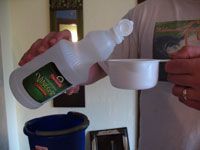 The greatest thing about learning how to clean windows from a pro like myself, is acquiring this remarkable recipe for window cleaner. Fill a bucket with about a gallon of warm to hot water. Add one cup of white vinegar and a splash of dish soap and stir briefly. If you are washing smaller windows, or car windows – fill up a spray bottle. Estimate on the ingredients – they don’t need to be exact. I add the dish soap only because I know that my windows were previously washed with a commercial cleaner – some of which leave a chemical residue. Vinegar makes for a great cleaning agent because of its antibacterial properties, effectiveness against dirt and grime, long shelf life, and it is also safe for you and the environment.
The greatest thing about learning how to clean windows from a pro like myself, is acquiring this remarkable recipe for window cleaner. Fill a bucket with about a gallon of warm to hot water. Add one cup of white vinegar and a splash of dish soap and stir briefly. If you are washing smaller windows, or car windows – fill up a spray bottle. Estimate on the ingredients – they don’t need to be exact. I add the dish soap only because I know that my windows were previously washed with a commercial cleaner – some of which leave a chemical residue. Vinegar makes for a great cleaning agent because of its antibacterial properties, effectiveness against dirt and grime, long shelf life, and it is also safe for you and the environment.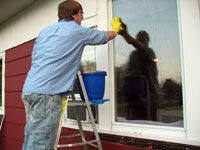 To clean larger windows, use the sponge. Apply plenty of solution using broad horizontal strokes on one side, and vertical strokes on the other or vice versa. This way, you’ll be able to see which side still has grime or streaks on it. Just because streaks appear doesn’t mean it was your cleaner. The windows could have been too hot from sunlight, or you may need to use a bit more dish soap to rid the window of previously used chemicals. To clean smaller windows, I just spray on the solution.
To clean larger windows, use the sponge. Apply plenty of solution using broad horizontal strokes on one side, and vertical strokes on the other or vice versa. This way, you’ll be able to see which side still has grime or streaks on it. Just because streaks appear doesn’t mean it was your cleaner. The windows could have been too hot from sunlight, or you may need to use a bit more dish soap to rid the window of previously used chemicals. To clean smaller windows, I just spray on the solution. To dry the larger windows, you’ll need the squeegee and the microfiber cloth. Using the cloth, dry the top horizontal edge and one vertical edge. Starting to “squeege” on dry glass will make the process much more effective. Start at the top, keep the squeegee at a slight downward angle, and overlap your start points. After each pass, dry the squeegee blade with the microfiber cloth. If you are cleaning smaller windows that would make using the squeegee difficult, just wipe the window dry using an old cotton shirt or lint-free towel (most dish towels), and finish with the microfiber cloth. This takes a bit more elbow grease, but looks just as nice.
To dry the larger windows, you’ll need the squeegee and the microfiber cloth. Using the cloth, dry the top horizontal edge and one vertical edge. Starting to “squeege” on dry glass will make the process much more effective. Start at the top, keep the squeegee at a slight downward angle, and overlap your start points. After each pass, dry the squeegee blade with the microfiber cloth. If you are cleaning smaller windows that would make using the squeegee difficult, just wipe the window dry using an old cotton shirt or lint-free towel (most dish towels), and finish with the microfiber cloth. This takes a bit more elbow grease, but looks just as nice. Your windows should now be almost imperceptible. I was shocked at how nice my windows looked, and regretted not cleaning them sooner. It was like going from VHS to Blu-Ray – everything was stunningly clear. I can now see what the Joneses are up to, and keep up with them. If your windows look like mine, you may even need to purchase a dead-bird recycling bin.
Your windows should now be almost imperceptible. I was shocked at how nice my windows looked, and regretted not cleaning them sooner. It was like going from VHS to Blu-Ray – everything was stunningly clear. I can now see what the Joneses are up to, and keep up with them. If your windows look like mine, you may even need to purchase a dead-bird recycling bin.
More Tips for Cleaning Windows
Paint Specks: Many people are concerned with how to clean windows with paint specks or splatters. Well, first I would recommend covering the windows next time you paint. Getting rid of dry paint on glass isn’t that hard, but it is an unneeded hassle. Simply get the window wet, and then scrape the paint off with a razor blade or even your fingernail.
Dirty Edges: If it’s been a long time since you last cleaned those windows, there may be a significant buildup of minerals along the edges. I would simply strengthen the cleaning solution by adding a bit more vinegar and then dry with the microfiber cloth. Using a smaller sponge, or even a cotton swab could prove useful.
Your dead-bird recycling joke wasn’t funny: Flawlessly clean windows, while we enjoy them, are a danger to birds. If you find that a particular window is confusing for birds, hang plants, sun catchers, or stained-glass art to help our feathered friends.
Natural Window Cleaning
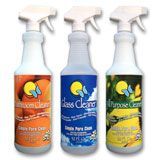 Simple. Pure. Clean. makes a glass cleaner that works well and is relatively inexpensive. Like many window cleaning products, what is actually in the container is very similar to the cleaner I make at home. Numerous products contain added coloring, because hey, purple cleans better. If you don’t want to mix your own window cleaner, this product is a good option.
Simple. Pure. Clean. makes a glass cleaner that works well and is relatively inexpensive. Like many window cleaning products, what is actually in the container is very similar to the cleaner I make at home. Numerous products contain added coloring, because hey, purple cleans better. If you don’t want to mix your own window cleaner, this product is a good option.
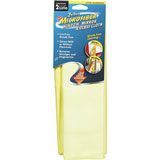 Zwipes Microfiber Window and Glass Cloth may be a bit on the expensive side, but unlike paper towels (which most people use for cleaning windows) you only have to buy them once. They are machine washable and super absorbent. If the size of your windows makes using a squeegee difficult, drying with microfiber cloth will give you the same sparkling finish.
Zwipes Microfiber Window and Glass Cloth may be a bit on the expensive side, but unlike paper towels (which most people use for cleaning windows) you only have to buy them once. They are machine washable and super absorbent. If the size of your windows makes using a squeegee difficult, drying with microfiber cloth will give you the same sparkling finish.
 Window Alert Decals spare birds a humiliating death by making them aware of the presence of windows. The decals, which are only slightly visible to the human eye, are brilliant to birds because they reflect ultraviolet light. Slapping some of these things on that bay window is a great way to say thanks for the songs, eating insects, and generally being pretty to look at. You can order a variety of packs, like the Leaf Medley Decal pack from Amazon.
Window Alert Decals spare birds a humiliating death by making them aware of the presence of windows. The decals, which are only slightly visible to the human eye, are brilliant to birds because they reflect ultraviolet light. Slapping some of these things on that bay window is a great way to say thanks for the songs, eating insects, and generally being pretty to look at. You can order a variety of packs, like the Leaf Medley Decal pack from Amazon.